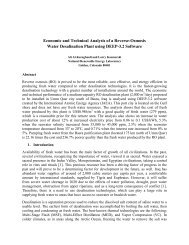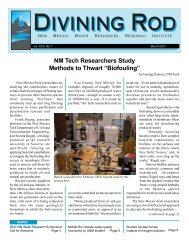Charles T. DuMars - Water Resources Research Institute
Charles T. DuMars - Water Resources Research Institute
Charles T. DuMars - Water Resources Research Institute
You also want an ePaper? Increase the reach of your titles
YUMPU automatically turns print PDFs into web optimized ePapers that Google loves.
Prior Appropriation Law and Future <strong>Water</strong> Allocation: Preserving <strong>Water</strong> for Future Generations<br />
THE PRIOR APPROPRIATION DOCTRINE,<br />
ITS BENEFICIARIES AND THE NEED FOR<br />
CHANGE<br />
The topic, prior appropriation, requires a little bit<br />
of definition. Most of you understand the basic<br />
definition, but we sometimes lose track of which<br />
members of society benefit the most from this doctrine.<br />
The prior appropriation doctrine of water law is of<br />
course that the first person to place water to beneficial<br />
use has the better right to use of that water. It exists in<br />
virtually all Western State constitutions. The principle<br />
is that if you beneficially use the resource, then you<br />
are entitled to have a better right in times of drought<br />
than someone else, that right being determined by the<br />
date you first applied the water to beneficial use.<br />
Who are the beneficiaries of that doctrine The<br />
beneficiaries in the Western United States can be<br />
loosely described as follows. Our economist friend will<br />
like this functional definition; the beneficiaries are the<br />
hardy risk-taking individuals who invest capital first by<br />
diverting the water and creating wealth. They are<br />
rewarded for their investment by being allowed the<br />
privilege of receiving the most water in times of<br />
shortage. There is, in effect, a bargain struck between<br />
those expending their capital to develop that resource<br />
and produce things and the state. For expenditure of<br />
their capital and producing wealth, these individual<br />
water right owners are given the best right in times of<br />
shortage.<br />
There are other beneficiaries. The courts<br />
throughout the nation recognize that Congress or mere<br />
aboriginal presence can offer benefit under that<br />
doctrine. Native American tribes are provided a priority<br />
date. Their quid pro quo for receiving an early priority<br />
date is not the actual use of the water but their mere<br />
presence of holders of an historical equity in the<br />
resource irrespective of use. If we think about it, if it<br />
were not for the prior appropriation doctrine<br />
establishing an early priority date, their aboriginal<br />
presence or the latter date of their treaty, or act of<br />
Congress creating a reservation, would be assigned a<br />
value of zero. The tribes would be forced to bargain in<br />
today’s society for a share of the resource in a way<br />
that under values their special value to the overall<br />
culture of this nation. Thus, the prior appropriation<br />
doctrine is vital in preserving their special place in our<br />
society.<br />
A third set of beneficiaries in New Mexico is the<br />
traditional Hispanic cultures of New Mexico, built<br />
around acequias. These are families whose use of<br />
water and physical presence predate the Treaty of<br />
Guadalupe Hidalgo and are the earliest documented<br />
non-Native American uses of water in this region.<br />
While the rights of land grant residents were<br />
dramatically watered down by the unfortunate<br />
Supreme Court cases interpreting the treaty of<br />
Guadalupe Hidalgo, the prior appropriative water rights<br />
of these groups survived<br />
those cases and give<br />
them a deserved special<br />
place as a function of<br />
their early use of the<br />
resource.<br />
Finally, the most<br />
important characteristic<br />
of the water resource<br />
under the prior appropriation<br />
doctrine is that<br />
the rights can be<br />
transferred, sold, or<br />
leased to others in times<br />
of shortage. The<br />
beneficiaries of this<br />
Finally, the most<br />
important<br />
characteristic of<br />
the water resource<br />
under the prior<br />
appropriation<br />
doctrine is that the<br />
rights can be<br />
transferred, sold or<br />
leased to others in<br />
times of shortage.<br />
characteristic are the entities that do not have sufficient<br />
water to survive a drought, but who can acquire rights<br />
from others in dry years and survive the weather<br />
extremes of our arid state. This ability to acquire rights<br />
from others through a market transaction is of course<br />
now loosely referred to as acquiring water rights in<br />
the water market.<br />
Prior appropriation doctrine works best if water<br />
can move from one set of users to another while<br />
maintaining the same priority date. In this example,<br />
economists would tell you that both the buyer and seller<br />
are made better off when such a sale or transfer takes<br />
place. Under this system, people with early priority<br />
dates will get the benefit of the capital value of that<br />
water right and the property it represents. This benefit<br />
could come in the form of a cash exchange to a private<br />
individual, a government loan or grant to build a water<br />
system for an Indian tribe in exchange for a sharing of<br />
shortages, or a program of forbearance whereby<br />
individuals are paid to forbear from use of their priority<br />
date and leave water in the stream for wildlife purposes.<br />
11
















